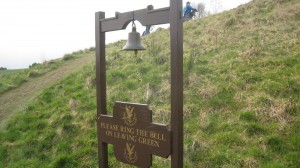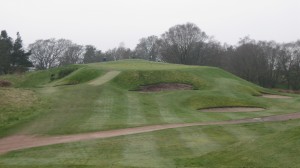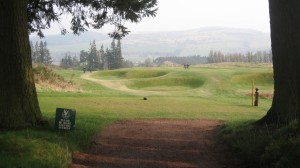Fourth in a series
AUCHTERARDER, Scotland – The bucolic rolling hills and hollows in lush Perthshire region of central Scotland is the ancestral and spiritual heart of the country.
Nearly a thousand years ago this area was churning in a revolutionary foment, with warriors such as William Wallace and Robert the Bruce leading the rebellion against English rule. This is Braveheart country, as the epic 1314 Battle of Bannockburn near Stirling is just 20 minutes away.
Never again can they take away our freedom. Or our golf courses.
Today, this area has been transformed into a glorious golf destination called Gleneagles. There are three distinctive courses here, two designed by legendary James Braid. He is responsible for designing more than 250 courses throughout Great Britain but Gleneagles’ Queens and Kings courses are considered among his finest work.
There is also the adjacent PGA Centenary course, opened in 1993 and designed by Jack Nicklaus, that will host the 2014 Ryder Cup.
For our Scotland golf experience, my son Bobby and I wanted an inland course to counter-balance the six coastal courses we would be playing all week. Gleneagles was the ideal choice. We settled on the Kings course, built by Braid in 1919.
“The Ryder Cup was only played in Scotland once, at Muirfield in 1973,” said Billy Murray, marketing manager for the swanky Gleneagles Hotel. “But Gleneagles held the first international match play event in 1921 on the Kings course. So it’s like a homecoming for the Ryder Cup, the way we see it.”
Gleneagles is in a valley with scenic views all around, the Ochil Hills, the rugged Grampian Mountains, the easily recognized round mound of Ben Vorlich and the wooded glens near the Trossachs.
After Lee Trevino once played the course, he mused, “if Heaven is as good as this, I sure hope they have some tee times left.”
Braid, also the five-time Open Champion, understood the challenges the golfers faced. And he introduced all of them into the Kings course, with a particular fascination for blind shots. He wanted to make sure you were precise with your shots. It’s a course that you will naturally get better the more times you play it because you’ll have better understanding of what’s beyond the dunes and ridges.
Take along a course guide, available at the pro shop, that gives you precise yardage readings and shows you images of each hole. You definitely need to know where you are hitting, even when you have no idea where that is.
As it was, Bobby and I played well despite our lack of advance knowledge. Bobby, who struggled with the Muirfield bunkers the day before, shot an 81 with eleven pars. I had an 85.
The opening 362-yard, par-4 hole is so Braid. It’s a vast fairway, plenty of safe landing spots, but as Murray pointed out, “it’s all in the second shot.” As so many holes are here. Depending on your drive position on the first, you might not see the flag. Your approach is all carry up an 80-foot embankment to a green that slopes toward you. If you fall short on your approach you most assuredly will trickle down into a pair of bunkers on the side of the slope that are like drool cups. They’ll catch anything.
The third hole, par-4, 374 yards, is much like the first hole but different. Your drive also will fall somewhere below a tall mound blocking the view to the green. But unlike the first, you have no idea how far to hit your second shot because the pin and green locations are uncertain, especially for first-timers. My approach sailed over the mound, over the green and onto a hill near the third tee. That cost me a shot or two.
After finishing, there’s a bell to clang for the next group to take their best guesses.
One of the great holes we played in our week in Scotland was the par-3, 149-yard fifth hole. Both the tee and green are elevated. There are four bunkers mostly in front. If you can’t hold the green, you will definitely end up in one of the bunkers or all the way down into the rough below. It’s called Het Girdle or Hot Pan.
My tee shot looped over the pin and I made the 18-foot putt for one of our rare birdies on the trip. Robert the Birdie.
In the group behind us – three engaging guys from Holland who coincidentally played behind us the day before at Muirfield – one of them bounced in a hole in one.
The par-4, 430-yard seventh is a challenge off the tee. The carry is about 200 yards over a ridge. Keep it right for more level fairway lie. I went left, mostly by accident, which cut into the dogleg left. Fortunately, I settled a yard from a trap and a ravine so I had a decent second shot.
Braid had a proclivity for protecting his greens with magnetic bunkers. Again at the par-4, 335-yard ninth, he placed two ample ones in front of the elevated green. Bobby had no trouble as this was his second of a three-hole par run – six overall for the front nine.
You’ll enjoy playing the par-4, 352-yard 12th hole. Yet again, there’s a ridge around your drive’s landing area. If you don’t clear it, you may end up in one of the steep bunkers along the ridge. Your only options are sideways or a severe loft shot over the ridge that still leaves another 180 yards to the green.
One of Braid’s customs was to sign his name to the hole he thought was the best creation on each of his courses. The par-4, 423-yard 13th, called Braid’s Brawest, was that hole here. From the tee, you see elevation changes, hills, slopes, dips and swales. It’s a fun hole, reflective of the course. We had a collective 11 on Braid’s Hancock.
Nine bunkers surround the par-3, 128-yard 16th. You need a straight shot here to the middle of the green. Bobby and I both stayed clear of trouble to par the hole but that would be our last measure of success.
The course finishes with a pair of challenging holes, including the par-5, 453-yard finale that, if you don’t clear the spine that traverses the fairway on your drive, you’ll have one last blind shot. It took a combined 23 strokes for us to close out the final two holes.
“The beauty of golf here is that any two days the wind can change and the winds makes a big difference,” said Murray.
We were quite fortunate because the wind was negligible. Our main weather element was a morning fog that delayed our start about two hours. But the mist just enhanced the myth of those long-gone Bravehearts.
PART FIVE: Crail – Tight by the sea




















